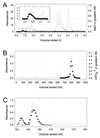Molecular characterization of KatY (antigen 5), a thermoregulated chromosomally encoded catalase-peroxidase of Yersinia pestis
- PMID: 10322012
- PMCID: PMC93766
- DOI: 10.1128/JB.181.10.3114-3122.1999
Molecular characterization of KatY (antigen 5), a thermoregulated chromosomally encoded catalase-peroxidase of Yersinia pestis
Abstract
The first temperature-dependent proteins (expressed at 37 degrees C, but not 26 degrees C) to be identified in Yersinia pestis were antigens 3 (fraction 1), 4 (pH 6 antigen), and 5 (hereafter termed KatY). Antigens 3 and 4 are now established virulence factors, whereas little is known about KatY, except that it is encoded chromosomally, produced in abundance, possesses modest catalase activity, and is shared by Yersinia pseudotuberculosis, but not Yersinia enterocolitica. We report here an improved chromatographic method (DEAE-cellulose, calcium hydroxylapatite, and Sephadex G-150) that yields enzymatically active KatY (2,423 U/mg of protein). Corresponding mouse monoclonal antibody 1B70.1 detected plasminogen activator-mediated hydrolysis of KatY, and a polyclonal rabbit antiserum raised against outer membranes of Y. pestis was enriched for anti-KatY. A sequenced approximately 16-kb Y. pestis DNA insert of a positive pLG338 clone indicated that katY encodes an 81.4-kDa protein (pI 6.98) containing a leader sequence of 2.6 kDa; the deduced molecular mass and pI of processed KatY were 78.8 kDa and 6. 43, respectively. A minor truncated variant (predicted molecular mass of 53.6 kDa) was also expressed. KatY is similar (39 to 59% identity) to vegetative bacterial catalase-peroxidases (KatG in Escherichia coli) and is closely related to plasmid-encoded KatP of enterohemorrhagic E. coli O157:H7 (75% identity). katY encoded a putative Ca2+-binding site, and its promoter contained three homologues to the consensus recognition sequence of the pCD-encoded transcriptional activator LcrF. rbsA was located upstream of katY, and cybB, cybC, dmsABC, and araD were mapped downstream. These genes are not linked to katG or katP in E. coli.
Figures





Similar articles
-
A surface-focused biotinylation procedure identifies the Yersinia pestis catalase KatY as a membrane-associated but non-surface-located protein.Appl Environ Microbiol. 2007 Sep;73(18):5750-9. doi: 10.1128/AEM.02968-06. Epub 2007 Jul 20. Appl Environ Microbiol. 2007. PMID: 17644638 Free PMC article.
-
Temperature sensing in Yersinia pestis: regulation of yopE transcription by lcrF.J Bacteriol. 1992 Jul;174(13):4275-86. doi: 10.1128/jb.174.13.4275-4286.1992. J Bacteriol. 1992. PMID: 1624422 Free PMC article.
-
Physiological and regulatory characterization of KatA and KatY in Yersinia pestis.DNA Cell Biol. 2008 Aug;27(8):453-62. doi: 10.1089/dna.2007.0657. DNA Cell Biol. 2008. PMID: 18466088
-
Yersinia pestis pH 6 antigen forms fimbriae and is induced by intracellular association with macrophages.Mol Microbiol. 1993 Apr;8(2):311-24. doi: 10.1111/j.1365-2958.1993.tb01575.x. Mol Microbiol. 1993. PMID: 8100346
-
Differential gene regulation in Yersinia pestis versus Yersinia pseudotuberculosis: effects of hypoxia and potential role of a plasmid regulator.Adv Exp Med Biol. 2007;603:131-44. doi: 10.1007/978-0-387-72124-8_11. Adv Exp Med Biol. 2007. PMID: 17966410 Review.
Cited by
-
Unveiling the dance of evolution: Pla-mediated cleavage of Ymt modulates the virulence dynamics of Yersinia pestis.mBio. 2024 Aug 14;15(8):e0107524. doi: 10.1128/mbio.01075-24. Epub 2024 Jul 3. mBio. 2024. PMID: 38958447 Free PMC article.
-
Bacteriophages fEV-1 and fD1 Infect Yersinia pestis.Viruses. 2021 Jul 16;13(7):1384. doi: 10.3390/v13071384. Viruses. 2021. PMID: 34372590 Free PMC article.
-
The oxidative stress response, in particular the katY gene, is temperature-regulated in Yersinia pseudotuberculosis.PLoS Genet. 2023 Jul 10;19(7):e1010669. doi: 10.1371/journal.pgen.1010669. eCollection 2023 Jul. PLoS Genet. 2023. PMID: 37428814 Free PMC article.
-
Widespread Occurrence of Non-Enzymatic Deamidations of Asparagine Residues in Yersinia pestis Proteins Resulting from Alkaline pH Membrane Extraction Conditions.Open Proteomics J. 2008 Jan 1;1:106-115. doi: 10.2174/1875039700801010106. Open Proteomics J. 2008. PMID: 20428468 Free PMC article.
-
A surface-focused biotinylation procedure identifies the Yersinia pestis catalase KatY as a membrane-associated but non-surface-located protein.Appl Environ Microbiol. 2007 Sep;73(18):5750-9. doi: 10.1128/AEM.02968-06. Epub 2007 Jul 20. Appl Environ Microbiol. 2007. PMID: 17644638 Free PMC article.
References
-
- Altschul S F, Gish W, Miller W, Meyers E W, Lipman D J. Basic local alignment search tool. J Mol Biol. 1990;215:403–410. - PubMed
-
- Baker E E, Somer H, Foster L W, Meyer E, Meyer K F. Studies on immunization against plague. I. The isolation and characterization of the soluble antigen of Pasteurella pestis. J Immunol. 1952;68:131–145. - PubMed
-
- Beers R F, Jr, Sizer I W. A spectrophotometric method for measuring the breakdown of hydrogen peroxide by catalase. J Biol Chem. 1952;195:133–140. - PubMed
-
- Blattner F R, Plunkett G, III, Bloch C A, Perna N T, Burland V, Riley M, Collado-Vides J, Glasner J D, Rode C K, Mayhew G F, Gregor J, Davis N W, Kirkpatrick H A, Goeden M A, Rose J, Mau B, Shau Y. The complete genome sequence of Escherichia coli K-12. Science. 1997;277:1453–1474. - PubMed
-
- Brubaker R R. Mechanisms of bacterial virulence. Annu Rev Microbiol. 1985;39:21–50. - PubMed
Publication types
MeSH terms
Substances
Associated data
- Actions
LinkOut - more resources
Full Text Sources
Other Literature Sources
Research Materials
Miscellaneous

